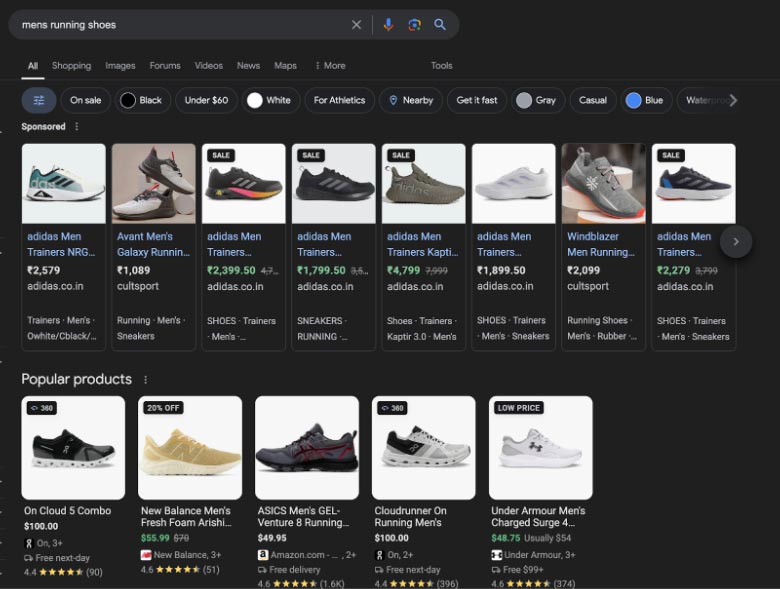 For any e-commerce business, getting more traffic is the holy grail. But how do you get more traffic to your online store without spending the big bucks on ads? Well, there’s one way you can do so — by leveraging SEO.
For any e-commerce business, getting more traffic is the holy grail. But how do you get more traffic to your online store without spending the big bucks on ads? Well, there’s one way you can do so — by leveraging SEO.
E-commerce search engine optimization (SEO) is a great strategy to build consistent traffic to your website and, when done well, has many benefits — improved brand awareness, more visitors, and of course higher sales!
That said the consistent updates and changes to search algorithms could leave you scratching your head. In this article, we look at some of the basics of e-commerce SEO including how to carry out keyword research, how you can structure your site, create engaging content that readers find useful and some other aspects to help rank your websites on search engines.
What Is E-commerce SEO?
E-commerce SEO involves steps you can take to ensure your online store gets more visibility and ranks organically on leading search engines like Google and Bing. Broadly, the best e-commerce SEO practices can be divided into the following verticals:
- Keyword research
- Website architecture
- On-page SEO
- Technical SEO
- Content marketing
- Link Building
Why Should E-commerce Websites Care About SEO?
When you search for any term on Google, the search engine result pages (SERPs) results typically throw up a few ads at the top of the page followed by 10 blue links that have reached there organically. When done right, e-commerce SEO enables your product pages to be visible within the top search results.

This is vital because people rarely visit websites outside the top 10 results. A recent research by Backlinko showed that only 0.63% of people visit websites listed on page two of Google search results.
Another research shows that the first result on a Google SERP gets 27.6% of all the clicks. This shows the importance of ranking on Google and more importantly — ranking on page 1 of Google SERPs.
1. Keyword Research
One of the most important aspects of a solid e-commerce SEO strategy is keyword research. Ecommerce keyword research differs from traditional keyword research, especially when it comes to intent.
Users typically make the following types of search:
- Product keywords (e.g., “women’s lipstick”)
- Category keywords (e.g., “men’s accessories”)
- Brand keywords (e.g., “Louis Vuitton bags”)
- Problem-solving keywords (e.g., “how to choose the right mobile phone”)
- Long-tail keywords (e.g., “best waterproof bags for camping”)
As an e-commerce store owner, your primary focus is to target consumers who are looking for products that you sell and this is where intent matters.
Searches on Google typically can be informational or transactional (other search types being navigational or commercial investigation). As an e-commerce store owner, it’s best to target a mix of the first two.
While traditional keyword research typically focuses on informational intent, e-commerce stores must always be on the lookout for “buying intent.” While this is something that e-commerce stores can directly target and show their products for, creating content on your website blog that satisfies a users “informational intent” is also a great way to attract traffic to your website.
One of the most basic ways to check what people are searching about is using Google’s autocomplete option.

An even more targeted way to check for “transactional” keywords is to use Amazon’s autocomplete option.

These autocomplete suggestions are a great source for keyword ideas. You can also check the related search queries at the bottom of the SERPs.
Another aspect to keep in mind when carrying out keyword research is “long tail keywords.” Long tail keywords (as the term suggests) includes more words that makes the search more specific.
For example, if your store sells school bags, instead of targeting the generic keyword “school bags,” a better way to go about it would be “school bags for girls 7-10,” or “school bags for boys 10-12.”

The more specific the search, the lesser the competition and logically, more traffic and more conversions.
Keyword Research Tools
While these are great ways to begin keyword research, to dive deeper, you’ll need access to keyword research tools that give you a deeper insight. Google Keyword Planner is a great free tool you can use.
Other options like Ahrefs or Semrush are great as well, but they charge a monthly subscription fee. Check whether the monthly subscription is something your marketing budget warrants.
Tip: When it comes to marketing tools like Ahrefs or Semrush, you can choose to pay for a one month subscription (typically costing $100 or $129 respectively for the basic license). You can carry out your research during the month and choose not to renew or renew at a later date.
With these tools, you’ll be able to analyze hundreds (even thousands) of keywords at once and understand which ones fit your strategy best.
These tools also allow you to enter your competitors’ domains and check the keywords they rank for. This gives you a fair idea of what your competitors are doing and how you can take advantage of these opportunities.
How to Choose Keywords?
While identifying keywords is a great way to attract traffic organically to your website, let’s be realistic — it’s not possible to rank for all the keywords out there. You’ll need to choose the ideal keywords based on a combination of several factors, such as your product offering and your target audience.
Some of the factors you’ll need to consider are:
- Search volume: Keyword tools like Google Keyword Planner, Ahrefs and Semrush give you an idea of how much monthly traffic a keyword typically gets. The higher the monthly search volume, the more probability of traffic to your website.
- Keyword Difficulty: While monthly search traffic is an important metric, you’ll need to combine it with the competition metric to get a realistic idea of your chances to rank for those keywords. For example, instead of choosing a keyword like “running shoes” with a monthly search volume of 1,000,000, you’ll be better off choosing another phrase like “best running shoes for flat feet” or “trail running shoes” with a monthly search volume of 10,000 with far less competition. This drastically increases your website’s chances of ranking for the keyword. Tools like Ahrefs and Semrush have a metric called keyword difficulty (KD) that measures how competitive a keyword is. The higher the KD, the more difficult it is to rank for it.
- Relevancy: Your product and category page also allows search engines to gauge the relevance of the keywords they are trying to rank for. If your product/category page is not relevant to the keyword you’re targeting, you’ll be far less likely to rank for the keyword.
- Search Intent: As explained earlier, choosing a mix of transactional and informational keywords is a great way of targeting users at different stages of their journey. While informational intent keywords typically target users at the top of the funnel, transactional intent keywords are typically used by customers who are close to making a purchase.
One vital aspect to remember is that you’ll need to create one page to target a specific keyword. Another thing to keep in mind while carrying out keyword research and devising your content strategy is to avoid keyword cannibalisation. This happens when two separate pages target the same keyword.
For example, if you’re targeting the keyword “can I freeze fresh pet dog food,” it’s a good idea to include other similar keywords such as “can I freeze fresh dog food,” or “can I put fresh pet dog food in the freezer.”
Tip: The best keyword(s) are those that have a high search volume and a low competition score and is something that is relevant to the products on your website.
2. On-Page SEO
You can start optimizing the content you’ve created based on your keyword research. Here’s a breakdown of the various aspects of on-page SEO you can optimize for.
A. Title Tags
Title tags appear as clickable headlines in search results and should include primary keywords relevant to the page’s content. For e-commerce sites, each product page should have a unique, descriptive title tag that includes the product name and relevant keywords.
B. Meta Descriptions
Meta descriptions provide a summary of the page’s content and appear beneath the title tag in search results. While they don’t directly influence rankings, compelling meta descriptions can improve click-through rates (CTR). Include keywords and a clear call-to-action to entice users to click on your link.
C. Header Tags (H1, H2, H3)
Header tags structure your content and make it easier for both users and search engines to read. Include primary and related keywords in your header tags.
D. Product Descriptions
Search engines use your page content to determine which keywords it can rank for. So if your page doesn’t have much content to begin with, search engines like Google don’t have much to go on. Creating unique, detailed product descriptions not only enhance user experience but also help search engines understand your content.
Avoid using manufacturer descriptions and instead, write original descriptions that highlight key features, benefits, and uses of the product. Incorporate relevant keywords naturally and include as much information as possible about the product that will help the customer make an informed decision.
E. Internal Linking
Visitors spending more time on your website gives search engines like Google a signal that they’re finding your content useful. This increases the chances of your page ranking higher and getting more eyeballs.
While getting backlinks from external websites is immensely useful, contextual internal links to other pages within your website also allow search engines to not only discover other pages on your website but also show them how vital these pages are.
Internal links help distribute link equity throughout your site and make it easier for search engines to crawl and index your pages. Link related products, categories, and blog posts to guide users through your site and improve SEO. Use descriptive anchor text that includes keywords where appropriate. Use the right (contextual) anchor text that links to other pages on your website.
3. Link Building
One of the proprietary functionalities Google built into their algorithm is PageRank — a system that determines page quality based on the number of links it has. A better way to explain this is the number of external websites that direct to your website.
Google measures the number of pages, their quality, and their relevance when it ranks pages, so it’s vital to satisfy all these scores.
Some of the things to keep in mind when building backlinks are:
- New websites with lesser links have low authority.
- Focus on quality links over quantity. Building quality backlinks can help Google recognize your authority faster.
- Google loves links from renowned .com, .gov, and .edu sites.
- Getting backlinks from other reputable or large websites within your niche are valuable
- It’s always a good idea to focus on creating useful content that gets linked to organically rather than choose link-farms that promise links in bulk but under deliver
- In a recent podcast, Google stated that “disavowing bad links to your website is not required” as their algorithm is smart enough to assess which links to trust without additional guidance. And the same thing is mentioned in Google’s documentation as well.
- Identify the types of content (such as infographics, surveys, statistics, etc.) you feel would attract organic links from other websites operating in your segment.
Another way to get lucrative backlinks is via media coverage. For example, running a survey within your industry and publishing these results in relevant online media publications could get your website a bunch of credible backlinks.
While hiring a PR agency to run such campaigns could cost you money, signing up for services like Help a Reporter Out (HARO) lets you get access to journalists who are looking for reliable sources for their stories.
Note: HARO is now Connectively, and has both free and paid versions that give different levels of access to journalist requests. Taking out a HARO subscription could still be less expensive than hiring a PR agency in most cases.
4. Content Marketing
Content marketing and SEO are often treated as separate entities, each with its own strategies and goals. However, when these two powerful techniques are combined, they can significantly enhance the visibility and success of your e-commerce business.
The goal of content marketing is to draw in and hold on to a certain audience by creating and distributing informative, timely, and well-written material. A variety of forms such as blog posts, articles, videos, infographics, podcasts, and social media posts can be used for this content.
Blogging and article writing are crucial components of a successful digital marketing strategy. They offer numerous benefits that help businesses connect with their audience, improve search engine rankings, and establish authority in their industry.
- Regular blogging provides fresh, relevant content that search engines favor, which can significantly improve your website’s SEO. Each new post creates an opportunity to rank for new keywords, driving more organic traffic to your site.
- Blogs and articles are effective tools for engaging with your audience. They allow you to address customer questions, provide valuable insights, and showcase your expertise. This builds trust and strengthens your relationship with your readers, encouraging repeat visits and fostering brand loyalty.
- Well-written content can position your business as a thought leader in your space. By consistently sharing informative and high-quality articles, you demonstrate your knowledge and reliability, which can attract more customers and partnerships.
- Blogs and articles are easily shareable across social media platforms, extending your reach and attracting new audiences. They also provide valuable content for email marketing campaigns, further enhancing your marketing efforts.
Create blogs for your e-commerce store, keeping these points in mind:
- Research what keywords to rank for. Publish content that targets keywords people are likely to search for when solving problems or making a buying decision. Optimize blog posts for SEO. Make sure each blog targets a specific keyword for SEO. Present your products as a solution to the problem. Every post doesn’t have to be about your products. But, don’t be afraid to link out to a product page or two when appropriate.
5. Technical SEO
Technical SEO is the backbone of your e-commerce site’s search engine optimization strategy. It involves optimizing the infrastructure of your website so that search engines can crawl, index, and rank your site more effectively. Here’s a detailed breakdown of the various aspects of technical SEO and how they contribute to improving your website’s ranking in Google SERPs:
A. Site Speed
A fast-loading website enhances user experience and is a crucial ranking factor for Google. Slow sites can lead to higher bounce rates and lower conversions. Optimize images, leverage browser caching, and minimize JavaScript to improve your site’s loading speed. Tools like Google PageSpeed Insights and GTmetrix can help you identify and fix performance issues.
B. Mobile-Friendliness
With the majority of online shoppers using mobile devices, having a mobile-friendly site is essential. Google uses mobile-first indexing, meaning it primarily uses the mobile version of your site for ranking and indexing. Ensure your site is responsive, meaning it adjusts to fit any screen size, and test it using Google’s Mobile-Friendly Test tool.
C. Secure Sockets Layer (SSL)
Security is a top priority for both users and search engines. An SSL certificate encrypts data transmitted between your site and its visitors, ensuring security and trust. Websites with HTTPS are preferred by Google, and having an SSL certificate can boost your rankings.
D. XML Sitemap
An XML sitemap helps search engines understand the structure of your website and find all your pages. It acts as a roadmap, guiding search engine bots to your important pages. Ensure your sitemap is updated regularly and submit it to Google Search Console.
E. Robots.txt File
The robots.txt file instructs search engine crawlers on which pages to crawl and index and which to ignore. Proper configuration of this file can prevent the indexing of duplicate or irrelevant pages, ensuring that search engines focus on your most valuable content.
F. Structured Data Markup
Structured data, or schema markup, helps search engines understand the content on your site better. By adding schema markup, you can enhance your search listings with rich snippets, such as product ratings, prices, and availability, which can improve your click-through rates (CTR).
G. Remove Duplicate Content Using Canonical Tags
Duplicate content can be created on your website without your knowledge and is a common challenge for e-commerce stores. A common example is when visitors to your website use the search bar, your website creates a temporary page to display the results.
These pages can be copies of original category pages already created while defining the site structure. Canonical tags help prevent duplicate content issues by specifying the preferred version of a webpage.
This is crucial for e-commerce sites with many similar or identical product pages. Implementing canonical tags ensures that link equity is consolidated to the main version of the page.
A canonical tag is a great way to let search engines know which pages in your site are copies or variations of the original content. This way search engines will only crawl the pages that have a canonical tag while ignoring the others.
Including canonical tags (“rel=canonical”) is also a great way to get more out of backlinks. With canonical tags in place, the links pointing to the page variations will all be directed to the original page, giving it more authority.
H. URL Structure
A clean and descriptive URL structure improves both user experience and SEO. Use short, readable URLs that include relevant keywords. Avoid using parameters like dates or years as they could be counterproductive when showing current results.
I. Broken Links
Google hates “404 errors.” Broken links can harm user experience and negatively impact your SEO. Regularly audit your site for broken links and either remove these pages or redirect them to other pages with similar content.
J. Image Optimization
Images are crucial for e-commerce sites but can impact load times if not optimized. Use descriptive file names and alt text that include relevant keywords to help search engines understand the image content. Compress images to reduce file size without compromising quality.
6. Site Architecture
A well-structured website is crucial for both user experience and search engine crawling. Creating a logical hierarchy is one of the first steps to consider while defining your site structure.
For example, a logical site structure for an e-commerce website would be – Home > Category > Subcategory > Product. Limit the depth of your site structure as creating a multi level hierarchy would make it difficult for visitors to understand where they are if they directly land on a product page.
A good rule of thumb here would be to aim for a maximum of 3 clicks or less to reach the lowest page (typically a product page) on the hierarchy.
Another vital aspect to consider is to use clear, descriptive URLs instead of confusing ones that are difficult to comprehend. An example of a clear URL would be yourdomain.com/category/product-name instead of a of yourdomain.com/cthe/bchty975.
Implementing breadcrumbs in your website is another useful way to make navigation easy for visitors to your website. The more time people spend on your website, the stronger the signal to Google that visitors enjoy being there and the more Google will reward you for that.
How to Get Started With E-Commerce SEO?
The foundation to a great SEO strategy is to create original content that is useful for people in your industry, as this what search engines like Google reiterate time after time when ranking pages. Be on the lookout for new search terms related to your product or brand you can rank for and regularly keep building organic links to your website, while keeping an eye on technical SEO aspects.
The frequent changes in search algorithms mean you have to be at the top of your game to first achieve search visibility and once you’re there, to continue your search presence. Having said that, following the best practices listed here should hold you in good stead to build a long-term SEO strategy for your e-commerce business.













